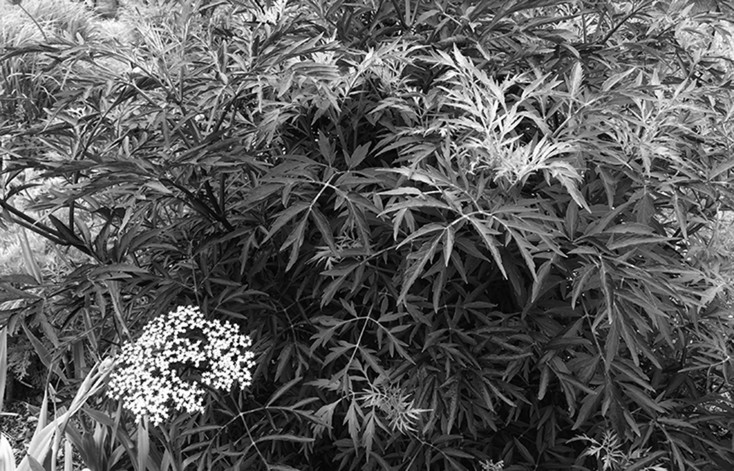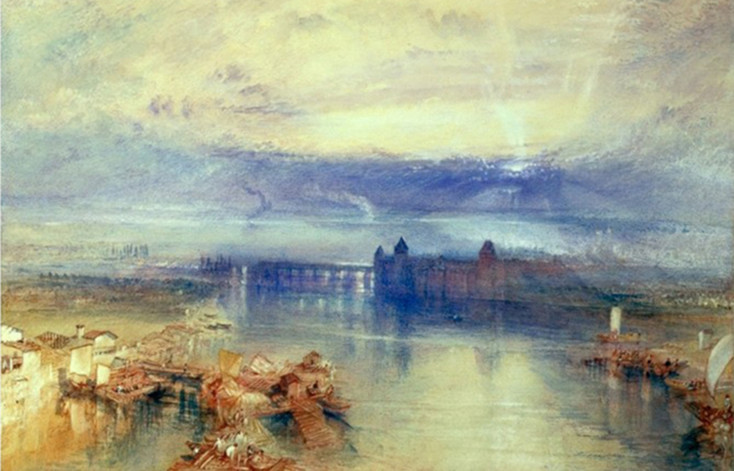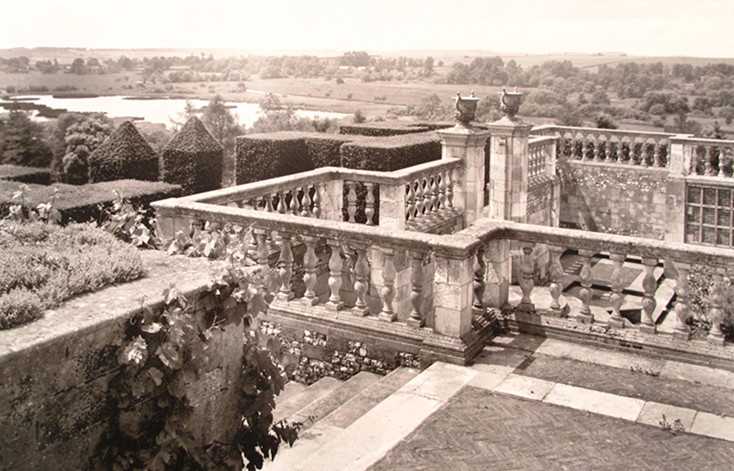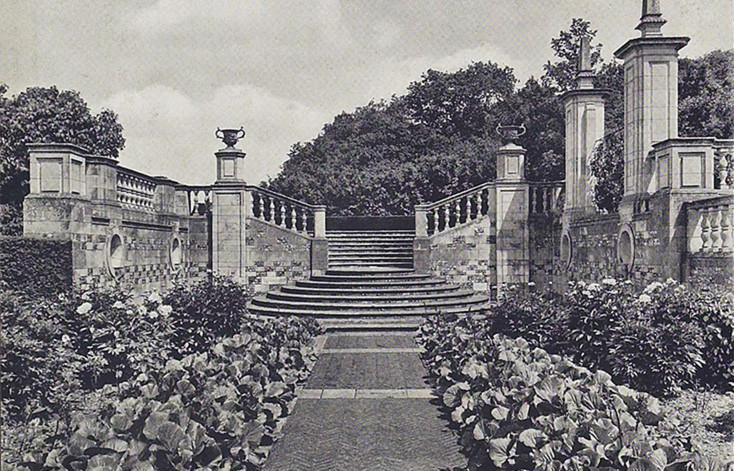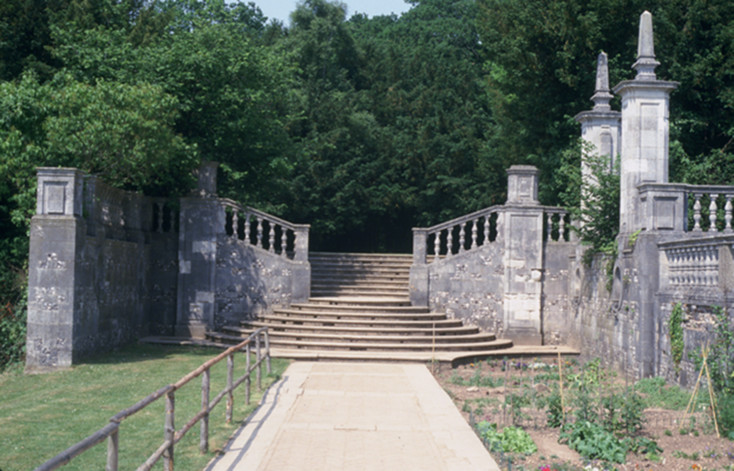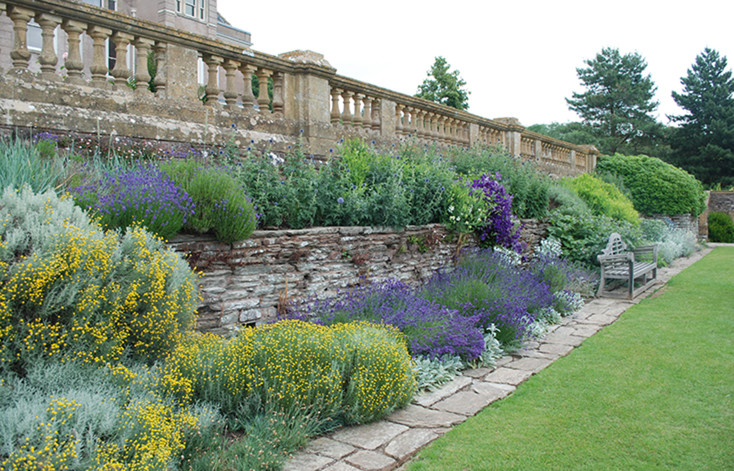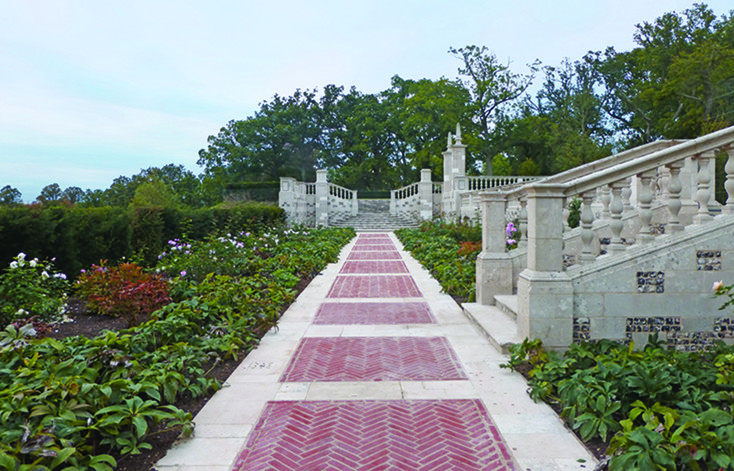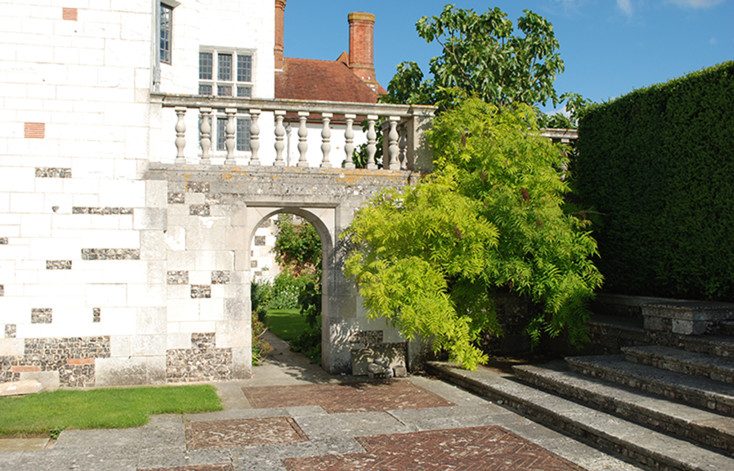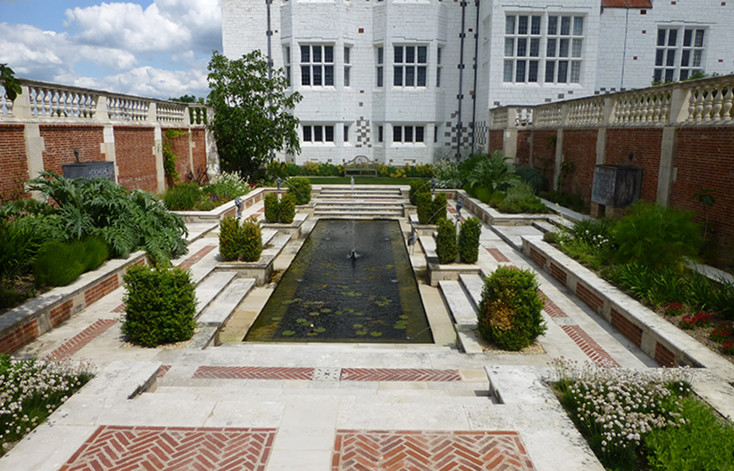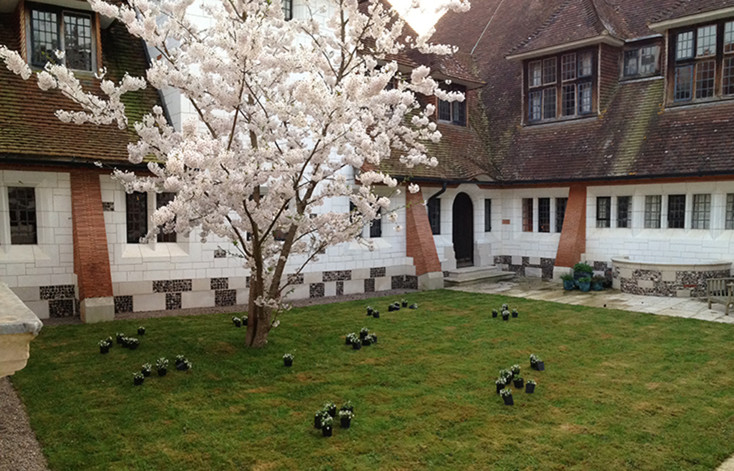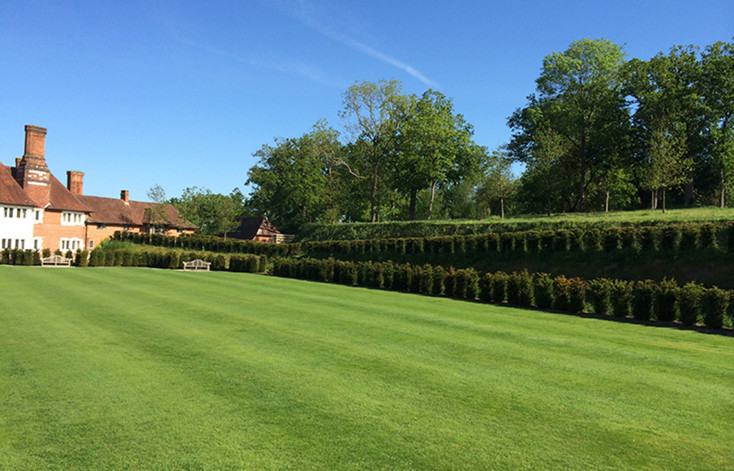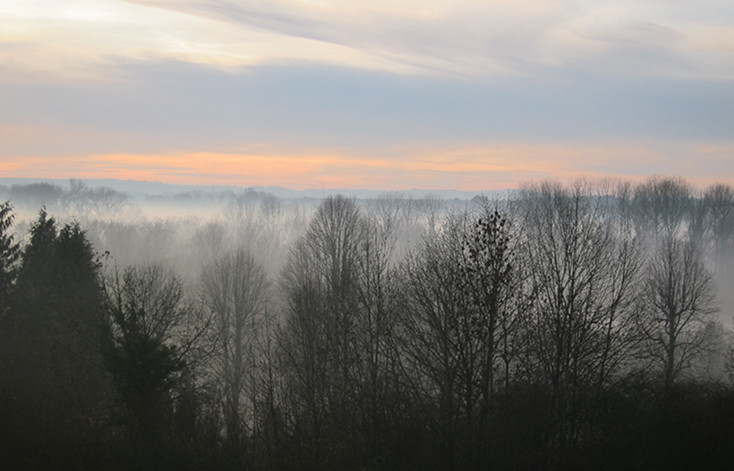Renewing the Gardens of Marshcourt
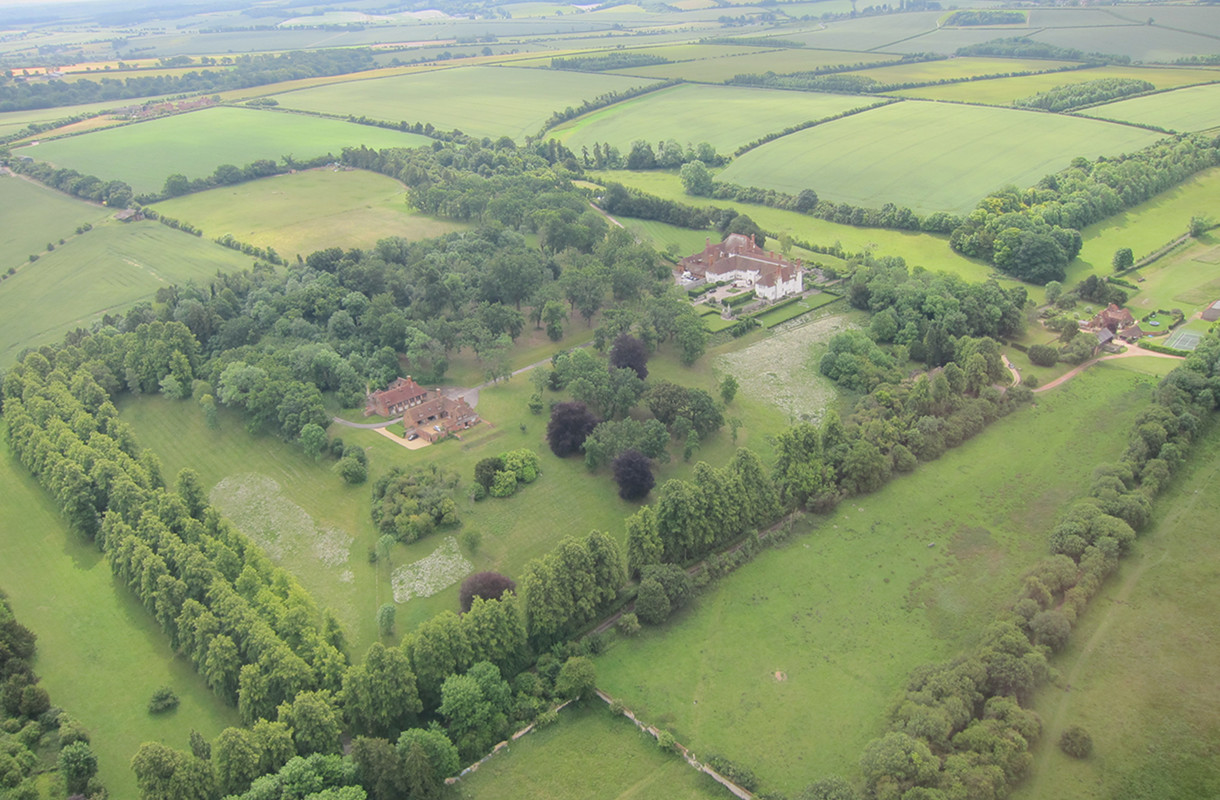
England’s quintessential Arts and Crafts gardens are rebuilt for this century.
Foreword
In 2010 the owners of Marshcourt commissioned Reed Hilderbrand to develop a master plan for the preservation and interpretation of its landscape. Originally encompassing 1300 acres outside of the village of Stockbridge in Hampshire, England, the property is situated along the edge of the Test River valley within a rolling terrain of hedgerow-lined fields. Designed by architect Edwin Lutyens for the financier Herbert Johnson, Marshcourt was constructed between 1901 and 1904, with a major addition between 1924 and 1926. It is a celebrated work of architecture and landscape design from the early twentieth century, and it stands as a quintessential expression of the Arts and Crafts Movement in Britain.
While design of the house and estate is attributed to Lutyens, archival evidence shows that his long-time collaborator Gertrude Jekyll played a role in the design of the extensive flower gardens around the house as well as a proposal for an outlying woodland garden that does not appear to have been realized. This article summarizes Reed Hilderbrand’s research on the historical development of the property and the conditions we discovered on site throughout our work. It presents these as the basis for understanding the landscape both as historic artifact and as cohesive contemporary composition, specifically focusing on the renewal of the series of garden rooms that surrounds the manor house.
Of note is that between Johnson’s tenure and the acquisition of the property by the current owners, documentation revealed significant alteration to key features of both the estate landscape and the gardens—the result of benign neglect and intention. In the case of the larger landscape, historic ordnance surveys and photographs as well as recollections of those who had been involved with the property for the preceding decade provided extensive guidance. Unearthing the original intent of the flower gardens was more difficult. Although the pages of the journal Country Life provided evidence of the garden rooms, no planting plans of the gardens have been found.
Renewal of the flower gardens therefore requires speculation about original intent and character. Given that these are now twenty-first century gardens, they must also respond to available resources and contemporary management practices. Below we describe the conceptual framework of the planting design proposals, including installation and management practices, and will set forth a clear and cogent rationale for rehabilitation and a guide for future stewardship.
Context: The Legacy of Lutyens and Jekyll
Much has been written about the creative partnership that Lutyens and Jekyll shared over the course of twenty-five years, beginning when he was a 27-year-old practitioner and she was a mature artist at 53. Lutyens’ significant contribution to England’s national architectural heritage and beyond is well documented. He has been described as England’s most important architect since Christopher Wren. (1, Brown, Jane, Foreward. Tankard, Judith B. and Van Valkenburgh, Michael. Gertrude Jekyll: A Vision of Garden and Wood, from Lutyen’s obituary, 1944. p.IX) At Marshcourt, as a young architect, Lutyens employed principles drawn from classical, picturesque, and vernacular design traditions into an inventive combination of architecture and site design that would embody ideals of the Arts and Crafts Movement. This aesthetic framework, which influenced all of the visual and performing arts, architecture, and landscape design over several decades at the turn of the twentieth century, served to bridge Victorian and Romantic traditions and twentieth century Modernism. (2. Arnett, Elizabeth Anne, Thesis: “Finding the Art Part in Landscape Architecture: A Look at Painting Influences on Color in the Garden.” University of Georgia, 2007)
Jekyll’s appreciation and affinity for England’s vernacular traditions of gardening and architecture, which she and Lutyens shared, are documented in her photography, writings, and their joint collaborations. She also joined with William Robinson on views of the naturalistic use of England’s indigenous flora in gardens. Her work revolutionized planting design in the late nineteenth century and continues to influence the character and expression of gardens today. (FN)
Her legacy as a colorist with flowers is also well known and has several compelling roots in the development of the arts and sciences of the late nineteenth century. She studied the theories of color harmonies developed by the French chemist Chevreul in the mid-nineteenth century that likely shaped her creative production of tapestries and flower gardens. Chevreul’s theories about the juxtaposition of complementary colors revolutionized the use and application of color in the arts and helped spawn Impressionism. Jekyll was also profoundly influenced by her close friend, the painter Hercules Brabazon, and the prescient work of JMW Turner. Their paintings dematerialized subjects into an atmosphere of subtle gradations of color—an approach she echoed in her own work. (3. Brown, Jane, Gardens of a Golden Afternoon. Van Nostrund Reinhold Company, 1982, p.25.)
Historic Estate Design
Prior to Reed Hilderbrand’s involvement at Marshcourt, Peter Inskip + Jenkins Architects, performed extensive documentary research summarizing the historical evolution of the estate design as a basis of plans for architectural restoration. Building on that record, Reed Hilderbrand examined available historic plans, ordnance surveys and photographs (including photographs of a visit to Marshcourt in 1984 by Douglas Reed), and documented existing site conditions, in order to establish Lutyens’ design intent for the landscape as context for the renewal of the flower gardens. The surveys, dating back to 1874, delineate an agrarian pattern of landforms and hedgerows, and highlight the “Marshcourt Copse,” an ancient oak/hazel woodland. These records helped to illuminate the relationships Lutyens intended between the site he found and the site he designed.
Undoubtedly influenced by Jekyll, Lutyens’ design for the house and grounds emphasizes the genius loci, defined most explicitly in the way it engages the geologic features of the site. One’s introduction to this approach is the dramatic choreography of the estate drive. Beginning along a tree-lined lane in the valley, the drive proceeds through a double allée of lindens bordered by meadow into a deep cut in the earth flanked by 1:1 embankments of vegetated chalk, some forty feet high in places. It gradually ascends from the shade of this cut into the light of a hedged court where the drive rotates 90º toward the entry to the house, which appears through the canopy of the historic copse at the end of a long approach through vegetated embankments.
This inventive concept for the site’s circulation departs from Picturesque traditions of fitting drives to follow the contours of irregular landform, and instead embeds the drive into a perpendicular cut in the earth — a deliberate move that reveals the properties of the chalk substrate and serves both to delay sight of the house and to dramatically modulate the visitor experience between light and dark, open and closed, meadow and woodland, and geometric and irregular features of the landscape.
The house itself is a great white building overlooking the Test River Valley. Constructed predominantly of chalk and flecked with flint and brick tile inlay, it is the most obvious nod to the local geology. Its vast mass rests on an elevated plinth established through dramatic terracing of the chalk subsoil—a massive reshaping of the side of the hill that allowed Lutyens to make the house appear as though “clinging to the chalk knoll on which it stands above the valley.” (4. Brown, Jane. Gardens of a Golden Afternoon. Van Nostrund Reinhold Company, 1982, p.72.)
To respond to the steep conditions Lutyens utilized a rectilinear system of masonry walls and earthen embankments of impressive scale that extend orthogonally from the house, to terrace the site and structure the sequence of garden rooms that wrap the house. Where masonry walls and balustrades end, a precisely regulated series of yew hedges complete the geometric figure of the garden rooms. Based on historic photographs and site structures that remain, these features—stepped masonry walls and balustrades, earthen embankments and formal hedges—are the primary ordering elements of the designed landscape and those through which Lutyens united the house and its site. Together, these features frame near and distant views, engage the site’s geology of chalk and flint, and incorporate flower gardens of varied character within the context of wildflower meadows, mixed-species hedgerows, and oak/hazel/beech woodlands of the larger property.
Period of Decline
From documentary research of the historic record and analysis of the existing conditions, we identified that notable change had occurred throughout the designed landscape after Johnson’s sale of the property: to the copse; to the original landforms that defined the estate drive and supported the house and its gardens; to the hedge system that was an integral part of the garden architecture; and to the planting of the gardens. The deterioration of the original fabric began in 1940 when the estate transitioned to the wartime use of housing evacuated children. In 1948, it then became the home of the Marshcourt Preparatory School. During the more than fifty years that the school owned the estate, garden rooms were adapted into sites for modular structures, the drive geometry was altered to accommodate larger vehicles, some masonry components in the gardens were removed, perennial beds were not regularly maintained and yew hedges were cut down or replanted without adherence to the original location, height or width that Lutyens had carefully calibrated to relate to the garden architecture.
The property returned to private ownership in 1989 and was owned by 2 different families before the current owners acquired it in 2008. During this period of previous ownership, the site design underwent an additional process of degradation through the removal of the original chalk embankments along the drive between the lodges and the house and along the back drive and tennis lawn (to allow for greater ease of mowing). The re-grading of the embankments into gentle, rolling slopes required significant clearing within the ancient copse, which further diminished the integrity of this unique, character-defining feature of the original designed landscape and negatively impacted many of the 200-year-old oaks. In the gardens themselves, although much of the masonry structure survived, little of the original planting remained.
Understanding Jekyll’s Role at Marsh Court and the Intent and Character of the Gardens
Within the walls and hedges that define the garden rooms at Marshcourt two primary characters are revealed: the first, expanses of open restrained fine lawn and the second, an effusion of perennials in beds set within detailed masonry. The historic record indicates that the lawn rooms are definitively Lutyens’ design. The documents related to the flower gardens suggest Jekyll’s involvement, but do not definitively establish her role or the extent to which she defined their character.
Scholars and the garden design world have benefitted from the volume of original material detailing Jekyll’s life, influences, convictions, and work—much of which is housed in the archives at the University of California, Berkeley. In the case of the perennial gardens of Marshcourt, however, the historic record of Jekyll’s participation is thin. Here Jekyll’s role is more implied than recorded or extant. Only cursory documentation exists as notations in her hand on a few surviving Lutyens drawings. Planting plans in her handwriting do exist for proposed 1915 renovations; however, the areas of the property these describe are remote from the house and it is unclear how many of these proposals, if any, were realized. (the photographic record does not include images of these areas and no evidence of them having been built exists on site).
While the record lacks direct evidence of Jekyll’s involvement in the perennial gardens, there is indication that planting plans may have once existed – as in a letter Lutyens wrote to Jekyll in 1915, “The Gardener (Eppe) is very pleased with your method of making plans, as he knows exactly where to put the plants.” (5, Lutyens, Edwin, Letter to Gertrude Jekyll, April 29th 1915, Gertrude Jekyll Collection, University of California Berkeley) Unfortunately, they have not made it into the historic record. We can assume that virtually nothing from the original planting of the gardens remains. The large figs located in and above the sunken garden, and the roses and grape vines that adorn the pergolas, may be the only original plants remaining.
In addition to the lack of primary source planting records and extant site evidence, it is clear from surviving correspondence and photographs that several hands had been at work in the gardens from their inception. Letters from 1915 confirm that the nursery Cheal and Sons were consulted on the planting, as was the property’s gardener, though Jekyll’s opinion was most desired “I [Lutyens] am sending you under separate cover the four plans in connection with the Marshcourt Gardens […] Cheal made the plans but Mr. and Mrs. Johnson would much rather that you [Jekyll] do the planting.” (6, Lutyens, Edwin, Letter to Gertrude Jekyll, April 29th 1915, INCOMPLETE, Gertrude Jekyll Collection, University of California Berkeley)
The original planting design of the garden rooms is most clearly documented in historic photographs — specifically those from Country Life (1913 and 1932) that include images of the Long Walk, Sunken Garden and Sundial Lawn. The photographs of the Sundial Lawn depict significant change in the garden over the early decades. Each of its manifestations lack cohesion and appear almost authorless. Here Jekyll may not have been involved in the design or her plans may not have been adhered to by the gardeners.
However, images of the Long Walk and the Sunken Garden demonstrate an approach to design with perennial plants that exemplifies principles of the Arts and Crafts Movement espoused by Jekyll—namely the emphasis on a garden’s ephemeral qualities and seasonal effects through the use of perennials, especially traditional, humble cottage garden flowers, familiar roadside natives, and plants from the Mediterranean that she often used in combination with stone paving and masonry walls. The Long Walk includes beds overflowing with peonies and roses bordered by a Jekyll staple, bergenia. And images of the Sunken Garden indicate several of her favorite plants including roses, ladies mantle, artemesia and santolina.
These photographs also evidence her way of grouping plants to create robust, impressionistic effects tailored to each garden. Plants are composed in masses scaled to relate to the size of the garden space, the imposing architectural enclosure, and the sweeping views of the distant landscape. As she herself wrote “The shaping of every group of plants to have the best effect should not only be definitely intended, but should be done with an absolute conviction by the hand that feels the drawing that the group of plants must have in relation to what is near, or to the whole form of the mass or to whatever the nature of the place may be.” (7, Jekyll, Gertrude. Colour Scheme in the Flower Garden, The “Country Life’ Library, Country Life, 1908, p. 138)
Because the images of the flower gardens are suggestive but not definitive about their original intent we set out to formulate a clear and cogent argument for change.
Concept for Sustained Renewal—Rehabilitation
Given that Marshcourt was built during the most intensive period of Lutyens and Jekyll’s long partnership—preceded by The Deanery Garden in 1901 and followed by Lambay Castle in 1908—it is likely that Lutyens turned to Jekyll in the development of the perennial gardens. However, with the limited historical record, the photographic evidence of significant change within the gardens even within the period of Johnson’s ownership, and little original planting remaining, a restoration of the gardens is not possible. There are also responsibilities in this undertaking to ensure a sustainable future for the garden’s renewal in a culture where available resources are more limited, which make restoration undesirable. Along with the new owner’s profound commitment to revive the significant legacy of Marshcourt, which was developed as a bachelor’s hunting lodge, they also bring a large family to the regular use and enjoyment of the property. We have therefore determined that rehabilitation is the only appropriate treatment for the flower gardens. In the case of the evergreen hedge system, where there is substantial evidence of its original form and maintenance regimes are less taxing, restoration has been pursued.
It should be noted that all of our work in the garden rooms is founded on the remarkable (and complete) restoration of all paving, walls and balustrades surrounding the house that was already underway when we arrived. The current owners incredible commitment to bringing these aspects of the property back proceeded under the skillful eye of Peter Inskip and Jenkins Architects. In the absence of this restoration, it would have been impossible to engage the renewal of the garden rooms and the remarkable procession through them.
The planting design of the gardens is predicated on four motivations: an interpretation of specific historic design intentions gleaned from the photographic record and informed by the well-documented theories, sensibilities, and preferences of Lutyens and Jekyll; an understanding of existing site conditions; response to the needs and aspirations of the current owners; and a commitment to more sustainable practices in the maintenance and management of the landscape.
The plant palette draws from several principles that Jekyll employed in her expressive work, including the use of hardy roadside natives and beloved cottage garden plants that she championed, and others we identified that share their loose habit and resilience; the incorporation of carefully selected exotics to intermingle with the familiars to dramatic effect; and the use of plants associated with the Mediterranean region whose character engages the garden’s inert mineral surfaces of stone and brick.
Throughout the gardens, plants are massed in large drifts to harmonize with the imposing scale of the architectural enclosure and the sweeping views of the landscape, and to produce robust and impressionistic effects tailored to each space. The palette combines hardy plants with subtle gradations of flower colors, complementary foliage texture and color, and fragrance. The design is calibrated to achieve these effects with less elaborate and less diverse borders than Jekyll would have planted.
The specific plant palette also acknowledges the site’s formidable constraints on gardening, including exposure to erratic weather patterns and challenging soil conditions, which make the initial establishment of plants unusually difficult. We knew from the estate manager that over time plants had struggled from the impact of the alkaline (chalk) subsoil affecting the planting soils. In some locations, like the Long Walk (where the roses and peonies require a rich loamy soil with a neutral pH) and the Sunken Garden (where the Mediterranean palette requires a less fertile, well-drained medium), we have pursued wholesale soil replacement to a 24” depth. In other places, like the Sundial Lawn, amending the existing soil with a healthy dose of aged compost has proved enough to support the proposed palette.
While the Long Walk is irrigated, the rest of the beds in the other gardens receive hand-watering only, so we focused on plants that are resilient to drought, including some that are native to the adjacent meadows. But at select places in the composition, we have amended conditions for specific plants that would heighten the intended effect. In most instances, these plantings have been successful. Where not, we have returned to a more dependable palette.
We continue to work with the garden staff and local growers to consider recent plant introductions that are good performers with more satisfying ornamental features or longer periods of bloom. Plants that are performing poorly instigate the probing of soils for moisture content and pH levels. Ultimately, we test alternative plant choices both for their adherence to the aesthetic intent and principles developed for each of the gardens in order to maintain consistency and coherence of character.
Caring for a garden is always an ongoing and dynamic challenge that must reconcile variables of plant cultural requirements with the gardener’s skills and sensibilities. The day-to-day success of the gardens depends on careful oversight by the estate’s gardeners, who, in conversation with our office, are developing a multilayered management regimen for watering, feeding, routine soil enhancement, pest-control, and pruning.
The planting designs have guided renewal of Marshcourt’s gardens according to a conceptual framework predicated on the findings of our historic research, existing site conditions, and a pursuit of sustainable practices. Yet we know that there will always be, and should be, change with a living medium. A plant originally designated for one location might be more striking in combination with plants in another area of the garden. A newly developed rose cultivar might intermingle well with the clematis climbing the masonry wall.
Embracing the reality of change is another way that we are bringing Jekyll’s legacy forward. For her, the purpose of the garden was not to create static and predictable effects. Instead she pursued the idea of the garden as a place continually offering dynamic, often fleeting, experiences. She also accepted the likelihood of horticultural successes and failures with the understanding that there would be occurrences of serendipity and calamity in the garden. But change was also desirable in order to achieve intended visual and sensory effects. For us and for the gardeners, as with Jekyll, managing change in the gardens requires the cultivation of a deep and practiced knowledge of horticulture, a nuanced and refined sensibility, and sheer enthusiasm for plants.
The Gardens
The Rendezvous Lawn
The Rendezvous Lawn is located off the entry drive and announces the series of garden rooms wrapping the house to the west and south. This square of fine lawn is bound by a clipped yew hedge and serves as a threshold between copse and house—wild and domestic—and provides a pause as one transitions to pedestrian travel. Future replacement of the yew hedging will restore the original relationships between masonry and hedge and allow the lawn to be returned to square.
The Long Walk
From the Rendezvous Lawn, arced stairs descend to The Long Walk. Here wide planting beds line a 45M long stone and brick path. The original character and composition of this garden room are well documented in the pages of Country Life and the new scheme draws heavily from it. Bound alternately by stone walls and a clipped yew hedge, the garden’s wide beds host a grid of peonies and repeat blooming roses in pink, white, cream and coral that echo the pattern of the brick paving and the structure of the original planting. Masses of hellebores in white, pink, and burgundy (bergenia in the original design) extend from the edge of the path into the beds and provide early season flowers and an evergreen edge. Adjacent to the hellebore planting, a carpet of Liriope spicata ‘Alba’ underlays the roses, completing the simple evergreen ground plane.
The Bowling Green
Bound by 8’ clipped yew hedges on three sides and a chalk meadow embankment on the fourth, The Bowling Green is an elongated room of fine lawn running below the Rendezvous Lawn and parallel to the Long Walk. Here we replaced (and extended) the entire perimeter hedge to re-establish historic relationships both with the broader site and with more local masonry elements. The embankments below the rendezvous lawn were graded back to 1:1 slopes and seeded with chalk meadow mix. The lawn, that had been designed to be perfectly flat and that had settled irregularly over time, was replaced with one that is perceptibly flat, but in reality pitched to drain. A new sod mix that can take the wear and tear of young boys’ games was installed throughout.
Long Walk Terrance
The Long Walk Terrace is a transitional space below and between the Long Walk to the north and the Long Walk Extension to the south. Here, two raised planter beds — one against the house and one against the western wall of the Sunken Garden — line mirrored sets of stairs. Historic images show a clump of exuberant Sorbaria tomentosa (a Jekyll favorite). This has been reinstated and paired with Salvia sclarea over a groundcover of Lysimachia nummularia ‘Aurea’ that provides evergreen cover once the Sobaria is cut back in fall. The brilliant chartreuse and soft texture of the Sorbaria foliage is a surprise flanked by the darker greens of the yew and box hedges to its north and south.
Long Walk Extension
The Long Walk Extension extends south from the Terrace and sits above and immediately to the west of the Sunken Garden. The photographic record describes several different characters for this room including a group of succulents. We have elected to reflect this shift in character along the length of the Walk. In contrast to the pinks and whites of the Long Walk, this Room embraces blues and greens. Its order is more informal, described by interlocking drifts, as is its character, which features looser plants that echo the chalk meadow to its west. Drifts of Borago officinalis, Echinops ritro, Catanache caerulea, Eryngium giganteum, E. oliveranum, Amsonia hubrichtii and Salvia officinalis move through Caryopteris clanondensis, Perovskia atriplicifolia, Nepeta x faasenii, and Aster oblongifolius. The asymmetry of the Long Walk Terrace continues in this bed where the west edge of the path is lined by a simple panel of fine lawn.
Sunken Garden
The Sunken Garden is the most unexpected of the garden rooms. Perched at the southwestern edge of Lutyens’ terracing and oriented toward the view of the river, this space is paradoxically enclosed, inward-facing and intimate. Intended to surprise with a bold contrast to the muted order of the Long Walk, the design boasts an abundance of contrasting textures, vibrant and diverse color and dramatic form. While the absence of a planting plan prevented a restoration approach, the character and origin of many of the plants relate directly to the original planting as described in the pages of Country Life.
The contemporary scheme draws attention to the richly articulated ground plane and envelops the visitor in vegetation. As it is predominantly a masonry garden, the plantings enlist dependable Mediterranean species that thrive in hot, dry conditions and recall a signature characteristic of Jekyll’s designs. Ballota pseudodictamnus and Santolina rosmarinifolia provide structure. Dramatic height and intense colors are provided by Cyanara cardunculus, Echium candicans, Crambe cordifolia, Phormium tenax ‘Atropurpureum’, and Crocosmia Lucifer. Foeniculum vulgare references Jekyll’s love of kitchen garden plants and Centranthus ruber ‘Alba’ her use of familiars. The walls of the garden will one day be clad in fig (replanted as in the original design), which will play against the finer textures of Wisteria floribunda ‘Alba’ and Clematis armandii ‘Apple Blossom’ among others. Nymphaea and Nelumbo colonize the central water surface.
Sundial Garden
Emerging from the Sunken Garden, one climbs two short levels, passing the Middle Terrace, to arrive at The Sundial Garden. Extending southward from the house’s primary living and dining areas, this “room” offers long views of the rolling agricultural fields and the floodplain of the Test. The limited historical record of this garden suggested it was an area of continual change that lacked clear intention and offered little guidance in renewal. The current design employs a minimal plant list to maximum effect. The simple pink, white and green palette emphasizes contrasting foliage textures and provides a recessive foreground to the broad views of the valley.
As the client uses this space for dining, oregano and thyme contribute fragrance and flavor. Beds to the east and west of the lawn plat share plants including Pulsatilla vulgaris ‘Alba’ and Cistus salvifolia ‘Prostratus’, striking a connection through commonality. They also showcase distinct species within each bed. The west bed favors lower growing plants (Veronica ‘Pink Damask’) or those with a floating character (Sanguisorbia tenufolia ‘Purpurea’ and Verbena bonariensis ‘Lollipop’), to allow views through and over, while the east bed, nearer the house, features taller (Penstemon ‘Pensham Plum Jerkham’, Anemone x hybrid “Honorine Jobert’) and darker plants (Angelica gigas, Anthriscus sylvestris ‘Ravenswing’).
At the northern end of the plat between the dining terrace and the house double, deep pink and white-flowering roses are scattered throughout a bed of Daphne x transatlantica and common thyme while to the south of the plat in the raised masonry planters, clouds of Gysophila paniculata float above a cover of evergreen Iberis sempervirens.
Middle Terrace and Southern Pergola Water Garden
These are both transitional spaces between garden rooms more than rooms of their own and as such are kept simple. The Middle Terrace is a narrow bed lining a stone and brick walk between the Sunken Garden and Sundial Lawn. Here Gaura lindheimeiri ‘Whirling Butterflies’ emerges from a field of Heuchera villosa. Together they provide long-flowering seasonal change and a connection to the meadow plants in the adjacent valley.
The Southern Pergola Water Garden, one of the few places where a record of Jekyll’s planting exists, we have followed the plan to use water lilies and pontederia. Though not noted on the original plan, Jasmine officinale climbs the walls, wafting its scent across the dining terrace on summer evenings.
Mulberry Court
In its current incarnation, The Mulberry Court is the product of the 1926 addition of the ballroom that completely enclosed a formerly 2-sided court with a Mulberry tree at its center. Although the original tree is long gone, the historic L-shaped stone path remains and now frames a bed of moss harvested from another property set to go into construction. Within this field sits a single Prunus yeodensis underlain by drifts of sweet violets. Narrow planting beds on the north and west edges are carpeted with Asarum europaeum punctuated by Aruncus diocus and complete the mosaic ground plane of this “woodland box.”
Tennis Lawn
The Tennis Lawn is the last of the garden rooms before you climb the hill and reenter the copse. Here again, the photographic record was very good. This gaming garden had historically been a 3-sided room open to the south and its views to the agricultural fields beyond. To the north, it was originally framed by a tall 1:1 embankment situated between two levels of clipped yew hedge (one at the lawn and another at the service drive above), to the west by a scalloped yew hedge alone and to the east by a gentle embankment and line of large loose yews. Over time, the structure of the “walls” of this room had completely disintegrated, the hedges had entirely disappeared and the embankment filled to flatten it so that it was easier to mow.
Restoration included the replanting of 275 yews, reinstatement of the embankment to the north, and removal of large yews to the south that had grown up the block the view. The project also restructured the eastern embankment to provide an elegant transition into the oak grove, which includes a new stone path—the first of several interpretive additions to the property. All of this has returned this gaming lawn—the family’s croquet pitch—to the originally intended structure of a formal room offering expansive views of the Test River Valley.
Afterword
To recapture the historical character of this quintessential garden of the Arts and Crafts Movement—and to sustain its idea for renewal—has required clarity of intention combined with a spirit of experimentation and continual adaptation. The gardens of Marshcourt are designed to resonate with the effusive and the ephemeral. Through the use of perennial plants, robust and impressionistic effects complement the exquisite patterned masonry of the architecture. The special narrative of Marshcourt lies in moving through these domestic garden rooms, where the Test River Valley and outlying fields are alternately hidden and disclosed, always enticing one to set out into the larger landscape. Within the gardens, there are the wafting of fragrances, the coming and going of blossoms and of Marshcourt bees, the softness of young stems transitioning to seed pods—a sensibility that is played out against the muscularity of the architecture and the constancy of the landform and evergreen hedges of the original scheme. These are qualities envisioned by Jekyll and Lutyens, but attained today according to a plan that interprets historic intent from an incomplete record, rigorously considers existing conditions, and reflects the guidance of an owner who wishes to make a new home for family life in the 21st century.
Footnotes
- 1, Brown, Jane, Foreward. Tankard, Judith B. and Van Valkenburgh, Michael. Gertrude Jekyll: A Vision of Garden and Wood, from Lutyen’s obituary, 1944. p.IX)
